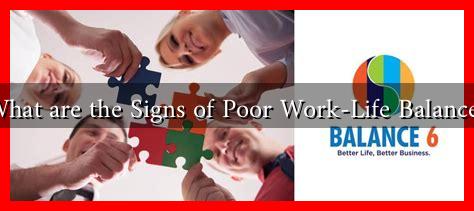-
Table of Contents
What are the Signs of Poor Work-Life Balance?
In today’s fast-paced world, achieving a healthy work-life balance is more crucial than ever. Many individuals find themselves overwhelmed by the demands of their jobs, leading to stress and burnout. Understanding the signs of poor work-life balance can help you take proactive steps to restore equilibrium in your life. This article explores the key indicators of an unhealthy work-life balance and offers insights into how to address them.
Understanding Work-Life Balance
Work-life balance refers to the equilibrium between personal life and professional responsibilities. A healthy balance allows individuals to manage their time effectively, ensuring that neither work nor personal life suffers. However, when this balance is disrupted, it can lead to various negative outcomes.
Common Signs of Poor Work-Life Balance
Recognizing the signs of poor work-life balance is the first step toward making necessary changes. Here are some common indicators:
- Constant Stress and Anxiety: If you find yourself feeling overwhelmed by work-related tasks, it may indicate an imbalance. Chronic stress can lead to anxiety disorders and other health issues.
- Neglecting Personal Relationships: A lack of time for family and friends can signal that work is taking precedence over personal life. This neglect can strain relationships and lead to feelings of isolation.
- Decreased Productivity: Ironically, working longer hours often results in lower productivity. If you notice a decline in your work performance, it may be time to reassess your priorities.
- Physical Symptoms: Stress can manifest physically, leading to headaches, fatigue, and other health problems. If you experience these symptoms regularly, it may be a sign of poor work-life balance.
- Inability to Disconnect: If you find it challenging to unplug from work, even during personal time, it may indicate an unhealthy attachment to your job.
- Loss of Hobbies and Interests: When work consumes your life, you may find that you no longer have time for activities you once enjoyed, leading to a sense of unfulfillment.
Case Studies and Statistics
Research supports the notion that poor work-life balance can have serious consequences. According to a study by the American Psychological Association, 61% of employees reported that work-related stress negatively impacted their personal lives. Furthermore, a survey conducted by Gallup found that employees who feel they have a poor work-life balance are 2.5 times more likely to experience burnout.
Consider the case of a marketing executive, Sarah, who worked 60-hour weeks consistently. Initially, she believed that her dedication would lead to promotions and recognition. However, over time, she began to experience anxiety, strained relationships with her family, and declining health. It wasn’t until she sought help and reassessed her priorities that she was able to regain control over her life.
Strategies for Achieving Work-Life Balance
Recognizing the signs of poor work-life balance is just the beginning. Here are some strategies to help restore balance:
- Set Boundaries: Clearly define your work hours and stick to them. Communicate these boundaries to your colleagues and supervisors.
- Prioritize Tasks: Use tools like the Eisenhower Matrix to distinguish between urgent and important tasks, allowing you to focus on what truly matters.
- Practice Self-Care: Make time for activities that promote your well-being, such as exercise, meditation, or hobbies.
- Seek Support: Don’t hesitate to talk to your employer about flexible working arrangements or seek professional help if needed.
- Unplug Regularly: Make it a habit to disconnect from work emails and calls during your personal time.
Conclusion
In conclusion, recognizing the signs of poor work-life balance is essential for maintaining both mental and physical health. By being aware of the indicators such as constant stress, neglecting personal relationships, and decreased productivity, individuals can take proactive steps to restore balance in their lives. Implementing strategies like setting boundaries, prioritizing tasks, and practicing self-care can lead to a more fulfilling and balanced life. Remember, achieving work-life balance is not just beneficial for you; it also enhances productivity and morale in the workplace.
For more insights on achieving a better work-life balance, consider visiting American Psychological Association.


